|
CONTENTS
Home Run Baker
Flint Went AWOL
Dizzy Tames Detroit
The End of a Career
Diz Nearly Upsets the Bombers
Deference to Hitting Streak - I
Deference to Hitting Streak - II
Almost Five HRs in Game
Baseball
Vignettes Index
Baseball Page
Golden
Rankings Home |
Home
Run Baker
John
Franklin Baker (who was "Frank"
to his family) is known to history as "Home
Run" Baker. This is a strange nickname for
a man who hit only 96 HRs in 13 seasons: 1908-14 with the Philadelphia
Athletics, 1916-1919 and 1921-22 with the New
York Yankees. The most Baker
hit in one season was 12 for Connie Mack's
A's in 1913. So
how did he get the "Home Run" moniker? By hitting
homers on consecutive days in the 1911 World Series against
the New York Giants.
Sporting News, October 26, 1911: "The Athletics
tied the score when Baker, their brilliant
third baseman, who won Monday's game with a home run, drove
one of Christy Mathewson's benders into the
far reaches of the right field stands for a homer in the ninth.
They won out in the eleventh on three safe hits, helped out
by two Giant errors
… When New York
forged ahead in the third, the echoes were awakened by a big
uproar. But when Baker, in the ninth, hit out
his homer, the din was deafening." Philadelphia
won in six games. One other Athletic
(CF Rube Oldring) hit for the circuit in the
Series, but no Giant
clouted a four-bagger.
The
5'11" 173 lb. Baker had other feats that
merited attention in that "Dead Ball Era" (before
1920).
- In
his first full season in 1909, he became the first player
to hit a ball over the right field fence at the newly constructed
Shibe
Park.
- He
ended his rookie year with a .447 slugging percentage, which
was fourth best in the American League. His 85 RBI was third
best while his 19 triples led all batters.
- He
led the American League in HRs (or tied for the lead) every
year from 1911 to 1914.
- Baker
held a 52-ounce war club at the handle and swung it as hard
as he could. He had developed his back, arms, and hands working
on his father's Maryland farm.
|
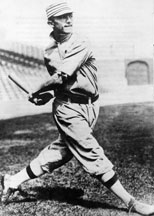 Frank "Home Run" Baker
Frank "Home Run" Baker
|
You
may have noticed in the listing of Baker's years
above that he did not play in 1915.
- After another A's
championship in 1914, Frank asked Mack
to renegotiate his three-year contract.
- When Connie
refused, Baker stayed on his farm, playing for the
Trappe town team.
- At the insistence of AL President Ban Johnson,
Mack sold Baker to the Yankees
for the 1916 season.
Frank's
absence for the 1920 season had nothing to do with salary or New
York's acquisition of Babe Ruth but
rather was motivated by personal tragedy. Scarlet fever took his wife
and almost claimed his two infant daughters. He returned for the 1921
season.
Reference:
Deadball Stars of the American League, The Society for
American Baseball Research, 2006 |
|
Dizzy
Tames Detroit
This is the first of three
Vignettes involving the one and only Dizzy
Dean. This one involves the seventh game of the 1934
World Series.
Led
by Dean's 30 victories – the last NL pitcher
to win that many in a season – the "Gashouse Gang"
Cards had overtaken
the Giants late in the
season. The Tigers
had bested the Yankees
by seven games. Both teams featured future Hall-of-Fame player-managers:
2B Frankie
Frisch for St. Louis and C Mickey
Cochrane for the AL champs.
- Dizzy
won Game 1 in Detroit 8-3.
- After the Tigers
took Game 2 behind their ace, Schoolboy Rowe, Dizzy's
brother
Paul won Game 3 in St. Louis, 4-1.
- However, Detroit
took the next two, 10-4 and 3-1. In the latter game, Tommy
Bridges outdueled Diz, who pitched eight
innings.
Down
3 games to 2, the Cards needed to win two games at
Navin Field. With SS Leo Durocher stroking three
hits, Paul Dean drove in the winning run to defeat
Rowe 4-3 and set up the ultimate game.
- 40,902
gathered to watch Dizzy pitch with two days rest
against Eldon Auker. (Oddly, this was fewer than
the 44,551 that had watched Game 6, which was on a Monday.)
- The visitors
took the suspense away with a 7-run outburst in the third. Meanwhile, Dizzy shut out the home team on six hits in an 11-0
romp.
The
game is most famous for an ugly incident that occurred in the top
of the sixth inning.
- Cardinal star Joe
"Ducky" Medwick stroked a triple to right center
that scored the Cards' 8th run.
- He slid hard into Tiger 3B Marv
Owen, who took exception and started kicking at Medwick,
who kicked back.
- The dugouts emptied but a melee was prevented and
the inning was completed.
- When
Medwick went to his position in LF at the end of
the inning, the bleacherites – frustrated that their heroes
were being denied a World Series championship for the fourth time
– took out their anger on Ducky by throwing
apples, oranges, pop bottles, cushions, and other items at him. (See
a video of the triple and resulting bleacher uprising. See if
you think the slide was anything out of the ordinary.)
- Medwick stayed out
of range while the grounds crew cleaned up.
- Twice more he tried to
take his position only to be greeted with more debris.
- Tiger
player-manager Mickey Cochrane walked out to LF to
plead with the fans to stop to no avail.
- Finally, Commissioner Kennesaw
Mountain Landis called Medwick and the two
managers to his box and ordered Joe to leave the game for his own
safety.
- When his replacement, Chick Fullis, took
the field, the fans cheered.
While
Medwick's departure had no consequence for the runaway
victory, it did deprive him of at least one more at-bat which might
have enabled him to tie or break several Series records. As it was,
he hit .379 with 5 RBI. He tied teammates Rip Collins
and Pepper Martin with 11 hits.
|
The
End of a Career
This is the second of three Vignettes involving the one and
only Dizzy
Dean. This one involves the 1937 All Star game.
The
American League hosted the fourth All Star game in Washington's Griffith
Stadium.
- Since Babe Ruth's retirement
in 1935, Dizzy had become baseball's most popular
player and biggest drawing card.
- He was on pace for a 25-win season
but, exhausted, asked to sit out the All-Star game but went at the
urging of Cardinal owner
Sam Breadon.
- He pitched the first three innings for
the NL while Lefty Gomez started for the fourth consecutive
year for the AL.
- Dizzy allowed two runs in the bottom
of the third before giving way to the Giants'
Carl Hubbell for the fourth inning. Gomez
tossed three shutout inning to become the winning pitcher for the
third time in All Star games as the Americans won 8-3.
However,
the play that makes this game memorable occurred in the bottom
of the third inning.
- Earl Averill of the Senators,
batting with two outs, hit a line drive off Dizzy's
right foot.
- When Averill was thrown out at
first, Dizzy walked to the dugout and into
the clubhouse.
- When he returned to St. Louis, he had his foot
examined. Discovering a broken big toe, the doctor put a splint
on it and told him to stay off it.
- After about a week, however,
a restless Diz had the splint removed.
What
happened next has been debated through the decades.
- Some insist Card GM Branch
Rickey, not believing Diz was that
badly injured, urged manager Frank Frisch to
pitch him.
- Frisch himself later said that Diz
was the one who insisted on returning to the mound.
- What is
certain is that Dizzy resumed pitching with
a very sore toe.
- To ease the pain, he unconsciously altered
his smooth pitching motion and hurt his arm.
- His famous fast
ball vanished, never to return.
- After winning 12 games before
the All-Star break, Diz won only one afterward.
Dean's
arm was still sore when he reported for spring training in 1938.
- So St. Louis traded
him to the Chicago Cubs for two pitchers, Curt
Davis and Clyde Shoun, outfielder
Tuck Stainback, and $185,000.
- That sets up
the third and last Vignette of this sequence.
Reference:The
Spirit of St. Louis: A History of the St. Louis Cardinals and Browns,
Peter Golenbock |
Diz
Nearly Upsets the Bombers
This is the third and final Vignette involving the one and
only Dizzy
Dean. This one involves Game Two of the 1938 World
Series.
Sore-armed
Dizzy had labored valiently for the Cubs
after he was traded by St. Louis before
the 1938 season.
- Pitching in only 13 games, he went 7-1 with a 1.81
ERA as Chicago won the pennant by two games over
the Pittsburgh Pirates.
- Gabby Hartnett's "Homer in the Gloamin'"
was the key blow as the Cubs returned to the Fall
Classic for the first time since 1932.
- As luck would have it, their
opponent would be the same New York Yankees
they had played in '32.
Hartnett,
who took over as manager from Charlie Grimm during
the season, called on Diz to start Game Two. The
Yankees had won the first
game 3-1 as Red Ruffing outdueled Bill Lee.
Dean's opponent was Lefty Gomez.
So the game could be billed as "Dizzy vs. Goofy."
- 28-year-old
Diz pitched valiantly for the 42,108 at Wrigley Field. He
gave up two cheap runs in the second when SS Billy Jurges
and 3B Stan Hack ran together on Joe Gordon's
grounder that scored two runs.
- However, the Cubs
led 3-2 going into the eighth. In today's baseball, Diz
would have been patted on the back and congratulated for giving the
home team seven great innings. The setup man would have pitched the
eighth and the closer, the ninth.
- However, no such strategy existed
in 1938. So Diz gave up a two-run homer to SS Frank
Crosetti – far from the Bronx
Bombers' power leader (only nine HRs in 1938) –
into the LF bleachers to give the visitors a 4-3 lead.
- Amazingly
(by today's standards), Diz returned to the mound
for the ninth but left after giving up a two-run homer to Joe
DiMaggio.
- The crowd gave him a standing ovation for holding
the mighty Yankees to seven
hits. However, the Cubs lost 6-3 on their way to
being swept.
Diz
pitched two more years for the Cubs, compiling a
9-7 record before being released in 1941 when it was obvious he would
never regain the fastball that had won him 30 games in 1934.
Top of Page
|
Deference to a Hitting Streak - I
|
|
Rick Manning should have been the hero for driving in the winning run. Instead, the home crowd booed loudly.
- Paul Molitor's hitting streak stood at 39 games on August 26, 1987 when the Milwaukee Brewers, then in the AL, hosted the Cleveland Indians before a crowd of 11,246.
- Molitor, batting leadoff as the DH, went hitless in four appearances against RHP John Farrell. Paul struck out, grounded into a DP, grounded out, and reached on an E by the 1B.
That fourth AB was interesting because the Indians went against "the book" to give Paul another shot at extending his streak.
- When he walked to the plate in the eighth, Dale Sveum was on second with one out. In a scoreless game, the standard strategy would have been to walk the hottest hitter in the league. However, the Indians pitched to him.
- Cleveland manager Doc Edwards confirmed after the game that he deferred to Molitor. "I had a gut feeling the percentages were running out on Paul." Doc had earlier praised Molitor for the classy way he handled himself during the streak and admitted that, as a fan, he rooted for him to continue.
It was a pitcher's night.
- All the Brewers had trouble with Farrell as he gave up only 3 hits and 0 runs in nine innings.
- Southpaw Teddy Higuera matched goose eggs with Farrell, also allowing only 3 safeties over 10 innings with 10 Ks.
Doug Jones took over in the bottom of the tenth.
- With the 6 hole hitter, LF Rob Deer, leading off, Molitor needed two men to reach base to get another chance or for the game to go to the 11th.
- Jones hit Deer with a pitch. Mike Felder pinch ran.
- 3B Ed Riles grounded out to the P, Felder taking second.
- The Indians intentionally walked SS Dale Sveum. Molitor's chances of another AB looked good.
- Rick Manning, a left-handed batter, pinch-hit for the 9th place hitter, 2B Juan Castillo.
That's when Manning made his big "mistake."
- He singled to CF, sending Felder home with the winning run.
- Coach Tony Muser, who did his job by waving Felder around third, recalled that "the boos were loud and forceful, then everyone was silent as if somebody had passed away."
- Rather wearing the hero's mantle, Manning joked that he would wear a bullet-proof vest to the park the next day.
- Molitor later said, perhaps in jest, that from the on-deck circle he waved Felder back to 3B so that the game would continue.
A similar situation in which a team pitched to a batter with a long streak when they could have walked him occurred 17 years earlier.
To be continued ...
|
|
Deference to a Hitting Streak - II
Sometimes a manager will go against conventional wisdom and pitch to a hitter who has a lengthy hitting streak on the line.
- Willie Davis of the 1969 Los Angeles Dodgers had hit in 30 straight games since switching to teammate Ken Boyer's heavier bat.
- The Dodgers hosted the New York Mets on September 3 in the third and final game of a series that was crucial for the Mets as they attempted to overtake the Chicago Cubs in the NL East.
- Willie struck out and grounded out twice against tough lefty Jerry Koosman.
When he came up again in the seventh, all signs pointed to it being Willie's last try to extend the streak.
- The Dodgers led 4-0 behind lefty Claude Osteen.
- With Osteen having extended his scoreless innings streak to 25, the odds indicated there would be no last of the ninth.
- Willie tried a drag bunt but was thrown out by P Cal Koonce.
Baseball has a way of disobeying the odds.
- In the top of the eighth, Tommie Agee and Don Clendenon cracked 2-run HRs to tie the score.
- The sudden turn of events so shook up the Dodgers that an odd situation occurred during the next AB. Here's Dodgers legendary announcer Vin Scully's play-by-play:
Ron Swoboda hits the ball to Osteen, who throws him out - and [Dodger manager] Walter Alston was on the field! He was heading to take Osteen out when Swoboda hit the first pitch back to the box.
The good news was that Davis might get another chance to extend his streak.
- In the bottom of the eighth, a 22-year-old reliever took the hill for the Mets.
- The inning was vintage early Nolan Ryan.
- He struck out RF Eddie Kosco.
- He walked 3B Bill Sudakis.
- With 2B Ted Sizemore at the plate, Sudakis stole second. Ryan then struck out Sizemore.
- Manager Gil Hodges ordered Tom Haller, batting for C Jeff Torborg, walked intentionally to get to the ninth spot in the Dodgers order.
- At that point, Scully explained the conundrum facing the Dodgers.
If the pitcher makes out, or whoever bats for him, then Willie Davis will then be the No. 3 hitter in the ninth inning - unless the Dodgers get a run and win it, of course.
- Alston sent up Willie Crawford to pinch hit. Scully continued to philosophize.
And boy this is a really tough one, isn't it? Crawford is trying to win the game. If he makes the last out in the eighth, Willie Davis will get another shot at extending his streak.
After reliever Pete Mikkelson pitched a scoreless ninth, Davis did indeed get another AB in the bottom of the inning.
- SS Maury Wills led off with a single off southpaw Jack DiLauro.
- As Manny Mota walked to the dish, Scully returned to his theme.
And for more of the fun for the folks in the stands trying to figure out about Willie Davis, if Mota sacrifices Wills to second, will they pitch to Willie? Left-handed pitcher on the mound. He's a left-handed batter.
- Mota did sacrifice, bringing Davis to the plate.
- Since the winning run was already at second, the situation seemed to dictate an intentional walk, although a switch-hitter, Wes Parker, was on deck.
And now we are faced with that situation - do you walk Willie Davis? He's getting an ovation. The one thing in his favor, oddly enough, is there's a left-handed pitcher on the mound. If there's a right-hand pitcher, the odds figure for sure they would walk him intentionally. But what will they do with a left-hander? I tell you what, if they walk him, you're going to hear a few boos.
- Hodges elected to pitch to Willie, who rapped the first pitch into LF for a double to win the game.
The next night in San Diego, Dick Kelley and Gary Ross shut out the Dodgers and ended Davis's streak at 31, which is still the club record.
|
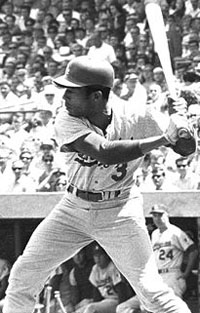
Willie Davis with Walter Alston (#24) behind hm
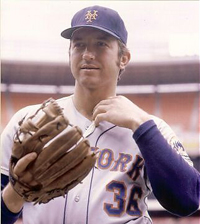
Jerry Koosman
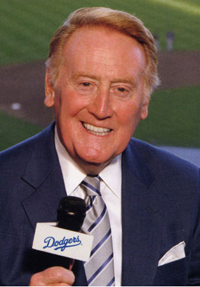
Vince Scully
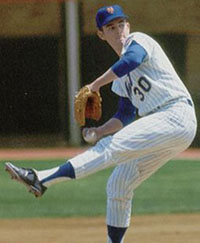
Nolan Ryan
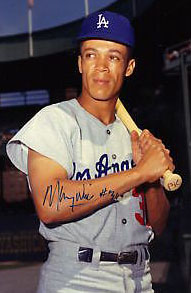
Maury Wills
|
Reference: "When Willie Davis' Streak Was on the Line ...," Dodger Thoughts, John Weisman on espn.com
Top of Page |
|
Almost Five HRs in One Game

Lou Gehrig
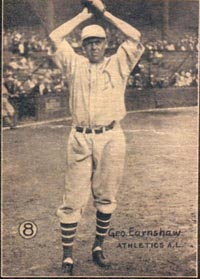
George Earnshaw

Leroy Mahaffey
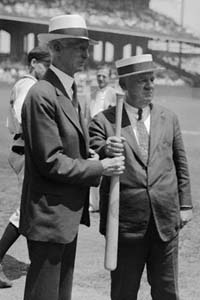
Connie Mack and John McGraw at first All-Star Game in 1933
|
On July 12, 1896, Ed Delahanty of the Philadelphia Phillies hit four HRs - all inside the park - in a National League game at Chicago. No one duplicated the feat until 1933 when Lou Gehrig had a sensational day at Shibe Park in Philadelphia.
- When he stepped into the batter's box in the first inning June 3, Larrupin' Lou had been in a slump with only seven round-trippers. He would increase that number by over 50% before the game ended.
- The P he faced, right-hander George Earnshaw, had won 68 games in the previous three seasons for Connie Mack's A's.
- Gehrig clouted a HR over the RF fence 331' away.
- In the fourth, he touched Earnshaw for another homer, also to RF.
- The next inning, he did it again to set a record, although no one realized it at the time. He had homered three times in a game four times in his illustrious career.
When Lou came up again in the seventh, he faced another RHP, Leroy Mahaffey.
- In the Philly dugout, Mack summoned Earnshaw to a spot beside him. "Sit here for a few minutes, son. I want you to see how Mahaffey does it. You've been pitching entirely wrong to Gehrig."
- Mahaffey threw a fast ball that Gehrig clouted over the LF wall. "I understand now, Mr. Mack," said Earnshaw. "Mahaffey made Gehrig change his direction."
- Gehrig not only tied Delahanty's 37-year-old record but also equalled the 1894 mark of Bobby Lowe of the Boston Nationals, the last man to hit four consecutive HRs.
The Yankee first-sacker came close to smashing a fifth HR, something no one has done in a game before or since.
- After grounding out in the eighth, he had a final chance in the ninth.
- With the "crafty" righty Ed Rommel on the mound, Gehrig blasted a tremendous drive to the deepest part of the park in CF. Al Simmons, who would enter the Hall of Fame because of his hitting, not his fielding, capped a long run with a last-second lunge to snag the ball just before it sailed over the wall.
- Recalling the day years later, Lou said, "The last ball I hit was the hardest of all that day. But Simmons caught up with it. How do you figure it?"
New York won the slugfest 20-13.
- Records fell all over the place as
the Yankees piled up a total of 50
bases on 23 hits, and the two clubs combined for 77 bases.
- The Yanks, in taking a firmer grip on first place in the American League, also equalled the big league record for HRs in a single
game with seven.
- Tony Lazzeri joined the symphony of Yankee bats with a HR, a triple, a double and two
singles, driving in six runs.
- Jimmy Foxx hit his 19th homer
of the year for the A's to raise his average to .415. Babe Ruth swatted his 15th.
So often overshadowed by The Babe, Gehrig found his feat relegated to the back pages of the sports section still again the next day.
- John McGraw, manager of the New York Giants for 30 years, chose July 3, 1933, to retire and hand over the reins to his 1B, Bill Terry, who would lead the Giants to the World Series championship that year over the Washington Senators.
- The New York Times featured McGraw's resignation on its front page. Gehrig's big day was relegated to page 10.
- A month later, McGraw would manage the National Leaguers in the first All-Star game against Mack's AL squad at Comiskey Park in Chicago.
Reference: Pennants & Pinstripes: The New York Yankees 1903-2002, Ray Robinson and Christopher Jennison
Top of Page
|
|